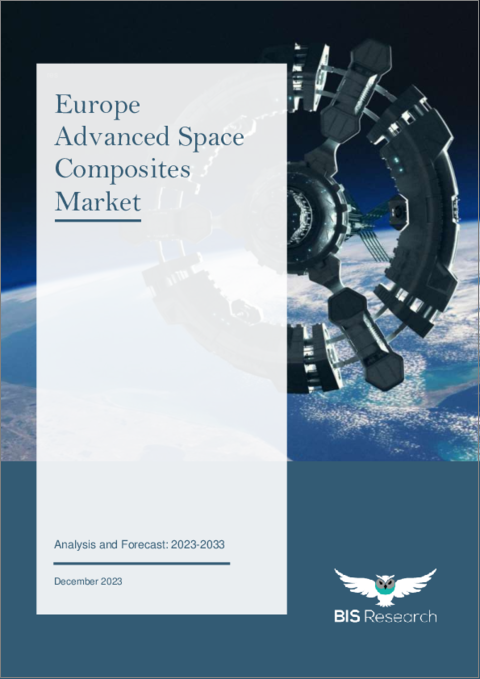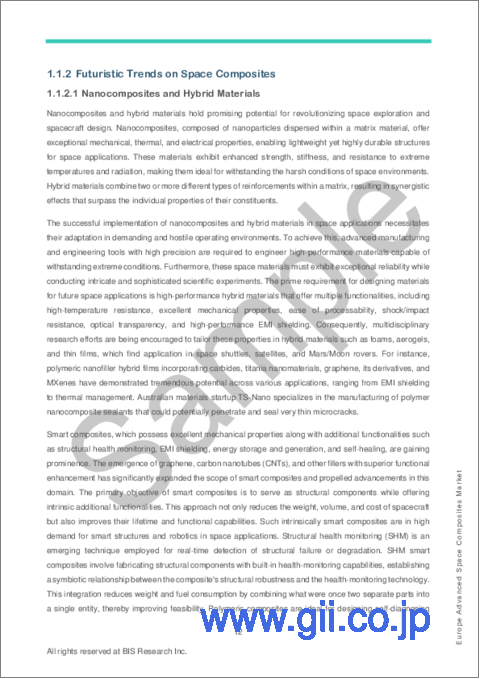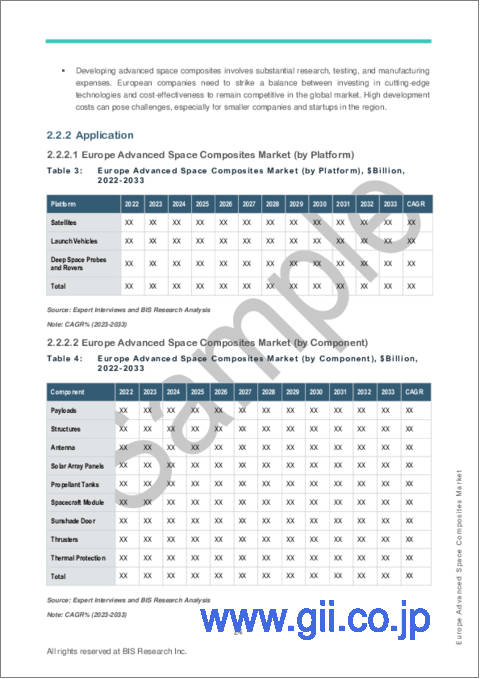|
|
市場調査レポート
商品コード
1396601
欧州の先進宇宙用複合材料市場の分析・予測:2023-2033年Europe Advanced Space Composites Market - Analysis and Forecast, 2023-2033 |
||||||
カスタマイズ可能
|
|||||||
| 欧州の先進宇宙用複合材料市場の分析・予測:2023-2033年 |
|
出版日: 2023年12月15日
発行: BIS Research
ページ情報: 英文 80 Pages
納期: 1~5営業日
|
- 全表示
- 概要
- 図表
- 目次
欧州の先進宇宙用複合材料の市場規模は、2022年の3億6,000万米ドルから、予測期間中は13.09%のCAGRで推移し、2033年には13億8,000万米ドルの規模に成長すると予測されています。
| 主要市場統計 | |
|---|---|
| 予測期間 | 2023-2033年 |
| 2023年評価 | 4億米ドル |
| 2033年予測 | 13億8,000万米ドル |
| CAGR | 13.09% |
欧州地域では、先進宇宙用複合材料の市場が急速に重要な産業になりつつあります。この成長の原動力は、宇宙探査や衛星技術を一変させる可能性を秘めた、堅牢で軽量な材料に対するニーズの高まりです。複合材料は、機械的、熱的、構造的に優れた性質を持つ材料であり、異なる要素をブレンドすることによって作られます。これらの材料は、宇宙システムの有効性と性能を向上させる大きな可能性を秘めています。
いくつかの興味深い市場が、宇宙技術における高度な複合材料の独創的な用途を支えています。例えば、人工衛星の構造やコンポーネントのための強固で軽量なフレームの製造は、複合材料に大きく依存しています。これらのフレームワークは、打ち上げ、真空、高温といった過酷な要件に耐えるように作られています。これらの材料は、より重いペイロードを搭載し、通信ネットワークを拡張し、科学および地球観測能力を向上させることができる、より大きく複雑な衛星を作成するために使用することができます。
当レポートでは、欧州の先進宇宙用複合材料の市場を調査し、市場の背景・概要、市場成長への各種影響因子の分析、R&D・特許の動向、法規制環境、使用事例、市場規模の推移・予測、各種区分・地域/主要国別の詳細分析、競合情勢、主要企業の分析などをまとめています。
市場の分類
セグメンテーション1:プラットフォーム別
- 人工衛星
- 打ち上げロケット
- 深宇宙探査機・ローバー
セグメンテーション2:コンポーネント別
- ペイロード
- 構造物
- アンテナ
- 太陽電池パネル
- 推進剤タンク
- 宇宙船モジュール
- サンシェードドア
- スラスター
- 熱保護
セグメンテーション3:材料別
- 炭素繊維
- ガラス繊維
- 熱硬化性
- 熱可塑性
- ナノ材料
- セラミックマトリックス複合材料 (CMC) および金属マトリックス複合材料 (MMC)
- その他
セグメンテーション4:製造プロセス別
- 自動ファイバープレースメント (ATL/AFP)
- 圧縮成形
- 積層造形
- その他
セグメンテーション5:国別
- ドイツ
- 英国
- フランス
- その他
目次
エグゼクティブサマリー
調査範囲
第1章 市場
- 業界の展望
- 先進宇宙複合材料市場:概要
- 宇宙用複合材料に関する未来の動向
- スタートアップと投資の情勢
- 主要な複合材料サプライヤーとプラットフォーム
- サプライチェーン分析
- 事業力学
- 事業 促進要因
- 事業上の課題
- 事業機会
- 事業戦略
第2章 欧州
- 先進宇宙用複合材料市場 (地域別)
- 欧州
- 市場
- 用途
- 製品
- 欧州 (国別)
第3章 競合ベンチマーキング・企業プロファイル
- 競合ベンチマーキング
- 企業プロファイル
- Airborne
- Beyond Gravity
- CRP Technology S.r.l
- EURO-COMPOSITES
- MT Aerospace AG
- その他の主要企業プロファイル
第4章 調査手法
List of Figures
- Figure 1: Advanced Space Composites Market, $Billion, 2023 and 2033
- Figure 2: Advanced Space Composites Market (by Platform), $Billion, 2023 and 2033
- Figure 3: Advanced Space Composites Market (by Component), $Billion, 2023 and 2033
- Figure 4: Advanced Space Composites Market (by Material), $Billion, 2023 and 2033
- Figure 5: Advanced Space Composites Market (by Region), $Billion, 2033
- Figure 6: Key Composite Suppliers for Satellite Components
- Figure 7: Key Composite Suppliers for Launch Vehicle Components
- Figure 8: Supply Chain Analysis
- Figure 9: Advanced Space Composites Market, Business Dynamics
- Figure 10: Global Satellite Launches Planned, 2023-2033
- Figure 11: Share of Key Business Strategies and Developments, January 2020-July 2023
- Figure 12: Advanced Space Composite Market, Competitive Benchmarking
- Figure 13: Research Methodology
- Figure 14: Top-Down and Bottom-Up Approach
- Figure 15: Assumptions and Limitations
List of Tables
- Table 1: Startups and Investments, January 2020-June 2023
- Table 2: Partnerships, Collaborations, Agreements, and Contracts, January 2020- July 2023
- Table 3: Market Developments, January 2020-July 2023
- Table 4: Advanced Space Composites Market (by Region), $Billion, 2022-2033
- Table 5: Europe Advanced Space Composites Market (by Platform), $Billion, 2022-2033
- Table 6: Europe Advanced Space Composites Market (by Component), $Billion, 2022-2033
- Table 7: Europe Advanced Space Composites Market (by Material), $Billion, 2022-2033
- Table 8: Europe Advanced Space Composites Market (by Manufacturing Process), $Billion, 2022-2033
- Table 9: U.K. Advanced Space Composites Market (by Platform), $Billion, 2022-2033
- Table 10: U.K. Advanced Space Composites Market (by Material), $Billion, 2022-2033
- Table 11: Germany Advanced Space Composites Market (by Platform), $Billion, 2022-2033
- Table 12: Germany Advanced Space Composites Market (by Material), $Billion, 2022-2033
- Table 13: France Advanced Space Composites Market (by Platform), $Billion, 2022-2033
- Table 14: France Advanced Space Composites Market (by Material), $Billion, 2022-2033
- Table 15: Rest-of-Europe Advanced Space Composites Market (by Platform), $Billion, 2022-2033
- Table 16: Rest-of-Europe Advanced Space Composites Market (by Material), $Billion, 2022-2033
- Table 17: Airborne: Product Portfolio
- Table 18: Airborne: Market Developments
- Table 19: Airborne: Partnerships, Collaborations, Agreements, and Contracts
- Table 20: Beyond Gravity: Product Portfolio
- Table 21: Beyond Gravity: Partnerships, Collaborations, Agreements, and Contracts
- Table 22: CRP Technology S.r.l: Product Portfolio
- Table 23: CRP Technology S.r.l: Market Developments
- Table 24: EURO-COMPOSITES: Product Portfolio
- Table 25: EURO-COMPOSITES: Partnerships, Collaborations, Agreements, and Contracts
- Table 26: MT Aerospace AG: Product Portfolio
- Table 27: MT Aerospace AG: Partnerships, Collaborations, Agreements, and Contracts
- Table 28: Other Key Player Profiles
“The Europe Advanced Space Composites Market Expected to Reach $1.38 Billion by 2033.”
Introduction to Europe Advanced Space Composites Market
The Europe advanced space composites market is estimated to reach $1.38 billion by 2033 from $0.36 billion in 2022, at a CAGR of 13.09% during the forecast period 2023-2033.
| KEY MARKET STATISTICS | |
|---|---|
| Forecast Period | 2023 - 2033 |
| 2023 Evaluation | $0.40 Billion |
| 2033 Forecast | $1.38 Billion |
| CAGR | 13.09% |
In the Europe region, the market for advanced space composites is quickly becoming a significant industry. The driving force behind this rise is the growing need for robust, lightweight materials that have the potential to transform space exploration and satellite technologies. Composites are materials with better mechanical, thermal, and structural qualities that are created by blending different elements. These materials provide great prospects to improve space systems' effectiveness and performance.
Several interesting market niches support the creative application of sophisticated composites in space technologies. For instance, the production of strong, lightweight frames for satellite structures and components depends heavily on composite materials. These frameworks are made to endure the harsh requirements of launch, vacuum, and high temperatures. These materials can be used to create bigger, more complex satellites that can carry heavier payloads, extend communication networks, and improve scientific and Earth observational capabilities.
Market Introduction
Within the aerospace industry, the Advanced Space Composites Market is rapidly growing and evolving, resulting in the Europe area becoming a prominent and active player on the global scene. Space research, satellite technologies, and many aerospace programs around Europe are being revolutionized by advanced space composites. These materials are designed with outstanding strength-to-weight ratios, remarkable endurance, and versatile applications in mind.
Market Segmentation:
Segmentation 1: by Platform
- Satellites
- Launch Vehicles
- Deep Space Probes and Rovers
Segmentation 2: by Component
- Payloads
- Structures
- Antenna
- Solar Array Panels
- Propellent Tanks
- Spacecraft Module
- Sunshade Door
- Thrusters
- Thermal Protection
Segmentation 3: by Material
- Carbon Fiber
- Glass Fiber
- Thermoset
- Thermoplastic
- Nanomaterials
- Ceramic Matrix Composites (CMC) and Metal Matrix Composites (MMC)
- Others
Segmentation 4: by Manufacturing Process
- Automated Fiber Placement (ATL/AFP)
- Compression Molding
- Additive Manufacturing
- Others
Segmentation 5: by Country
- Germany
- U.K.
- France
- Rest-of-Europe
How can this report add value to an organization?
Product/Innovation Strategy: The product segment helps the reader to understand the different types of solutions available for deployment and their potential in Europe region.
Growth/Marketing Strategy: The Europe advanced space composites market has seen some major development by key players operating in the market, such as partnership, collaboration, and joint venture. The favored strategy for the collaboration between government space agencies and private players is primordially contracting the development and delivery of advanced materials and specialized composite components for space system applications.
Competitive Strategy: Key players in the Europe advanced space composites market have been analyzed and profiled in the study, inclusive of major segmentations and service offerings companies provide in the technology segments, respectively. Moreover, a detailed competitive benchmarking of the players operating in the Europe advanced space composites market has been done to help the reader understand how players stack against each other, presenting a clear market landscape. Additionally, comprehensive competitive strategies such as partnerships, agreements, and collaborations will aid the reader in understanding the revenue pockets in the market.
Methodology: The research methodology design adopted for this specific study includes a mix of data collected from primary and secondary data sources. Both primary resources (key players, market leaders, and in-house experts) and secondary research (a host of paid and unpaid databases), along with analytical tools, are employed to build the predictive and forecast models.
Data and validation have been taken into consideration from both primary sources as well as secondary sources.
Key Market Players and Competition Synopsis
The companies that are profiled have been selected based on inputs gathered from primary experts and analyzing company coverage, product portfolio, and regional presence.
Some of the prominent names in this market are:
|
|
Table of Contents
Executive Summary
Scope of the Study
1. Markets
- 1.1. Industry Outlook
- 1.1.1. Advanced Space Composites Market: Overview
- 1.1.2. Futuristic Trends on Space Composites
- 1.1.2.1. Nanocomposites and Hybrid Materials
- 1.1.2.2. Thermally Resistant Materials for Space Applications
- 1.1.2.3. Self-Healing Composites for Space Applications
- 1.1.2.4. Metal Matrix Composites for Space Applications
- 1.1.2.5. Bio-Composites for Space Applications
- 1.1.3. Startups and Investment Landscape
- 1.1.4. Key Composite Suppliers and Platforms
- 1.1.5. Supply Chain Analysis
- 1.2. Business Dynamics
- 1.2.1. Business Drivers
- 1.2.1.1. Growing Satellite Launches and Deep Space Activity
- 1.2.1.2. Development of Reusable Launch Systems (Orbital and Suborbital)
- 1.2.2. Business Challenges
- 1.2.2.1. High Cost Associated with Space Composites
- 1.2.3. Business Opportunities
- 1.2.3.1. Advancements in Additive Manufacturing of Composites for Space Applications
- 1.2.3.2. Use of Composites in In-Space Transportation Systems
- 1.2.4. Business Strategies
- 1.2.4.1. Partnerships, Collaborations, Agreements, and Contracts
- 1.2.4.2. Others
- 1.2.1. Business Drivers
2. Europe
- 2.1. Advanced Space Composites Market (by Region)
- 2.2. Europe
- 2.2.1. Market
- 2.2.1.1. Key Players in Europe
- 2.2.1.2. Business Drivers
- 2.2.1.3. Business Challenges
- 2.2.2. Application
- 2.2.2.1. Europe Advanced Space Composites Market (by Platform)
- 2.2.2.2. Europe Advanced Space Composites Market (by Component)
- 2.2.3. Product
- 2.2.3.1. Europe Advanced Space Composites Market (by Material)
- 2.2.3.2. Europe Advanced Space Composites Market (by Manufacturing Process)
- 2.2.4. Europe (by Country)
- 2.2.4.1. U.K.
- 2.2.4.1.1. Market
- 2.2.4.1.1.1. Key Players in U.K.
- 2.2.4.1.2. Application
- 2.2.4.1.2.1. U.K. Advanced Space Composites Market (by Platform)
- 2.2.4.1.3. Product
- 2.2.4.1.3.1. U.K. Advanced Space Composites Market (by Material)
- 2.2.4.1.1. Market
- 2.2.4.2. Germany
- 2.2.4.2.1. Market
- 2.2.4.2.1.1. Key Players in Germany
- 2.2.4.2.2. Application
- 2.2.4.2.2.1. Germany Advanced Space Composites Market (by Platform)
- 2.2.4.2.3. Product
- 2.2.4.2.3.1. Germany Advanced Space Composites Market (by Material)
- 2.2.4.2.1. Market
- 2.2.4.3. France
- 2.2.4.3.1. Market
- 2.2.4.3.1.1. Key Players in France
- 2.2.4.3.2. Application
- 2.2.4.3.2.1. France Advanced Space Composites Market (by Platform)
- 2.2.4.3.3. Product
- 2.2.4.3.3.1. France Advanced Space Composites Market (by Material)
- 2.2.4.3.1. Market
- 2.2.4.4. Rest-of-Europe
- 2.2.4.4.1. Application
- 2.2.4.4.1.1. Rest-of-Europe Advanced Space Composites Market (by Platform)
- 2.2.4.4.2. Product
- 2.2.4.4.2.1. Rest-of-Europe Advanced Space Composites Market (by Material)
- 2.2.4.4.1. Application
- 2.2.4.1. U.K.
- 2.2.1. Market
3. Competitive Benchmarking and Company Profiles
- 3.1. Competitive Benchmarking
- 3.2. Company Profiles
- 3.2.1. Airborne
- 3.2.1.1. Company Overview
- 3.2.1.1.1. Role of Airborne in the Advanced Space Composites Market
- 3.2.1.1.2. Customers
- 3.2.1.1.3. Product Portfolio
- 3.2.1.2. Business Strategies
- 3.2.1.2.1. Market Developments
- 3.2.1.3. Corporate Strategies
- 3.2.1.3.1. Partnerships, Collaborations, Agreements, and Contracts
- 3.2.1.4. Analyst View
- 3.2.1.1. Company Overview
- 3.2.2. Beyond Gravity
- 3.2.2.1. Company Overview
- 3.2.2.1.1. Role of Beyond Gravity in the Advanced Space Composites Market
- 3.2.2.1.2. Customers
- 3.2.2.1.3. Product Portfolio
- 3.2.2.2. Corporate Strategies
- 3.2.2.2.1. Partnerships, Collaborations, Agreements, and Contracts
- 3.2.2.3. Analyst View
- 3.2.2.1. Company Overview
- 3.2.3. CRP Technology S.r.l
- 3.2.3.1. Company Overview
- 3.2.3.1.1. Role of CRP Technology S.r.l in the Advanced Spaces Composites Market
- 3.2.3.1.2. Customers
- 3.2.3.1.3. Product Portfolio
- 3.2.3.2. Business Strategies
- 3.2.3.2.1. Market Developments
- 3.2.3.3. Analyst View
- 3.2.3.1. Company Overview
- 3.2.4. EURO-COMPOSITES
- 3.2.4.1. Company Overview
- 3.2.4.1.1. Role of EURO-COMPOSITES in the Advanced Space Composites Market
- 3.2.4.1.2. Customers
- 3.2.4.1.3. Product Portfolio
- 3.2.4.2. Corporate Strategies
- 3.2.4.2.1. Partnerships, Collaborations, Agreements, and Contracts
- 3.2.4.3. Analyst View
- 3.2.4.1. Company Overview
- 3.2.5. MT Aerospace AG
- 3.2.5.1. Company Overview
- 3.2.5.1.1. Role of MT Aerospace AG in the Advanced Space Composites Market
- 3.2.5.1.2. Customers
- 3.2.5.1.3. Product Portfolio
- 3.2.5.2. Corporate Strategies
- 3.2.5.2.1. Partnerships, Collaborations, Agreements, and Contracts
- 3.2.5.3. Analyst View
- 3.2.5.1. Company Overview
- 3.2.6. Other Key Player Profiles
- 3.2.1. Airborne
4. Research Methodology
- 4.1. Factors for Data Prediction and Modeling






